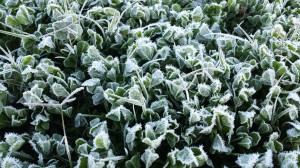Frost Protection for Southwest Gardens

Frosted vegetation on a winter morning.
photo: Jamie Manser
One of the best reasons to be a gardener in Tucson is the fact that, in Southern Arizona, we can have a garden growing all year long. Unlike other parts of the country where the ground freezes solid in the winter, Tucson winters are mild enough to grow a wide variety of cool season vegetable crops such as broccoli, lettuce and spinach. However, just because these crops don’t mind the cool temperatures doesn’t mean that we don’t need to give them some protection from time to time.
Mid- to late November, and through December and January, are usually the times of year we can expect to experience our frost temperatures. Light frost occurs between 32-28 degrees. Most winter vegetable crops can handle short exposure to these temps with little to no damage; however it is at these temps where summer vegetables will die off. A hard frost occurs as temperatures dip below 28 degrees. The longer it stays below hard frost temperatures, and the lower they get, the more likely your winter vegetable garden will experience frost damage.
Other weather factors such as wind, humidity and cloud cover also play an important role in how frost affects your vegetable garden. Clear, calm nights with little or no cloud cover will let warm air escape back into the atmosphere increasing the chances of frost damage. Moisture in the atmosphere holds heat which can protect your plants, while wind can help keep cool air from sinking to ground levels where your plants reside.
If frost is in the forecast, you can take some basic steps that will help increase the chances your plants will make it through the night. First, a two inch layer of alfalfa hay mulch should be applied to any vegetable garden. Not only does the mulch act as a slow release fertilizer and provide a living environment for soil microbes, but the mulch also acts as a great insulator that keeps plant roots warm on chilly nights. Intensive spacing of vegetable crops will also aid in protecting plants from frost damage.
A good next step is to water your garden the morning before you’re expecting a frost. The water in the soil will act as an insulator absorbing the sun’s heat during the day and radiating it back at night. You can also protect your vegetables with water by lightly misting them. Misting your plants works to protect them by creating an igloo like effect that keeps temperatures above hard frost levels.
You can help warm air stay close to plants by covering them at night with a sheet or frost cloth, but be sure to never use plastic. Frost cloth or frost blankets are a light material designed to keep warm air trapped against the ground where plants are growing. Frost cloth is nicer than sheets because it allows sunlight to reach the plants so they can be left on during very cold days whereas sheets need to be removed in the morning. It can also be doubled up to increase protection.
Garden centers and hardware stores will often sell out of frost cloth when a freeze warning arrives, but Tucson Organic Gardeners usually keeps a good supply on hand. For frost cloth to work most effectively, it needs to cover the plants
completely to the ground without touching them. You may need to construct a frame around your garden using PVC or wire fencing to keep the frost cloth from touching the tops of plants.
Another effective tool for your frost protection arsenal is a strand of old Christmas lights. Christmas lights radiate heat and can act as mini heaters in your garden. Simply place strands around the garden on frosty nights.
For the most part, we only need to take these precautions a few times a year, but it is nice to be prepared for the worst. Frosts can be frustrating but they actually have benefits; they limit the numbers of pest insects, kill off non-native invasive plant species, and also increase the flavor of many winter vegetable crops. So don’t be discouraged if a frost is in the forecast, just be prepared.
Brandon Merchant is the proprietor of Southwest Victory Gardens. Visit his website at SouthwestVictoryGardens.com.
Category: Community, FOOD & DRINK, Nature




